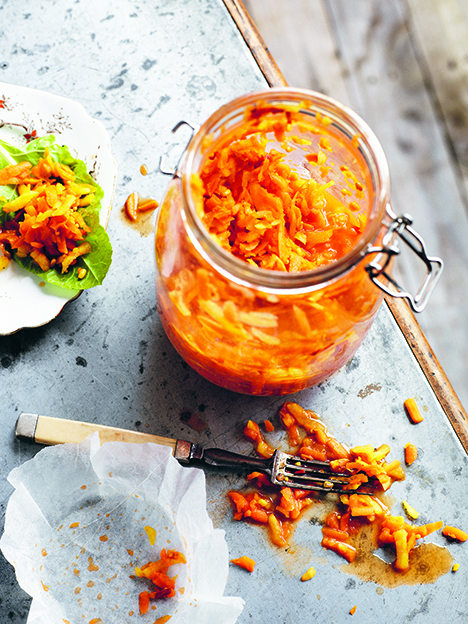Kimchi is hands down THE best probiotic food out there. I add it to my meals on a regular basis and figured it’d be a good idea to share why it’s so bloody good for you…as well as a recipe from my latest book I Quit Sugar: SIMPLICIOUS. Yeah, for free.

Probiotics vs prebiotics
Before I start ranting about the health benefits of kimchi I’ll distinguish between the two ‘biotics. Folk can get them confused.
* Probiotics are live “good” bacteria that aid the digestive system by controlling the growth of “bad” bacteria. That lactobacillus acidophilus in yoghurt…that’s a probiotic.
* Prebiotics on the other hand are non-digestible food fibres that enable probiotics to stick to the bowel wall and helps stimulate their growth. Fibres found in foods that typically make us fart are prebiotics (they travel to the large intestine intact where the “good” bacteria tries to break it down, facilitating “good” bacteria growth and…gas).
The two go hand in hand.
So why are probiotics so important?
Bacteria are crucial to human health. In fact, the vast community of bacteria (also called the microbiome) outnumbers our cells by a factor of 10 to one. Having a balanced and healthy microbiome is crucial to maintain our body’s key functions and overall health. You can read more about this in my elevator guide to the microbiome.
Is kimchi the best probiotic out there?
Well, science speaks for it. In a 2011 study published in the journal, Nutrition Research, it was found that fermented kimchi had a significant positive impact on blood sugar and blood pressure and has also shown to lower cholesterol, prevent constipation, and combat colon cancer. In addition, it can help to reduce stress, relieve depression, combat osteoarthritis, reduce atherosclerosis, and fighting liver disease.
Why? Well, in addition to the live bacteria lactobacillus acidophilus, kimchi is traditionally made with other ingredients jam-packed with health-boosting vitamins and nutrients.
I make mine with daikon and carrot. Here’s why that’s super good for you:
- Daikon boosts the digestive enzymes we need to break down fats, complex carbohydrates and proteins.
- It’s also been shown to counteract the carcinogens in processed and fried foods, which is why it is traditionally served with tempura in Japan.
- Even better, when eaten with foods high in beta-carotene (um, like carrots!) daikon improves the body’s ability to absorb vitamin D.
- And, further still…when’s the best time to make this little combo I’ve put together you may ask? Funnily enough, at the end of summer when carrots and daikon are at their peak . . . and just as we’re heading into the darker months. Which is when our vitamin D levels drop. Oh, it’s all such a beautiful thing!
See how this kinda gives it an advantage over your average tub of yoghurt?
My Indian Kimchi
Makes 4-6 cups
- 800 g–1 kg carrots, peeled
- 1 daikon, peeled
- 5–7 cm knob of turmeric, peeled
- 2 large red chillies, finely chopped (or 3 teaspoons chilli flakes)
- 2 teaspoons fenugreek seeds
- 2 teaspoons mustard seeds
- 2 tablespoons Himalayan pink salt OR 1 tablespoon salt and 1⁄4 cup Homemade Whey
Grate the carrots, daikon and turmeric (use the grater attachment on your blender or food processor) and place in a glass or ceramic bowl. Add the rest of the ingredients. Mix and let sit for 20 minutes to allow the salt (and whey, if using) to release the juices. If it’s not looking juicy enough, use a mallet or pestle to ‘massage’ the veggies to release the juices.
Spoon into a large jar with a lid. Press down on the veggies so the juices rise up to cover them. Put a weight on top to submerge the veggies and put the lid on loosely. Allow to sit at room temperature for 3–5 days (1–2 weeks if you don’t use whey) before sealing tightly and moving to the fridge, where it will last for up to 3 months I use salt to make kimchi because to get the best ‘fizzy’ vibe, the ferment needs to be slowed down a little. Of course, if your house is cooler than, say, 20°C, feel free to prod things and use a bit of whey and less salt.
Have you made my kimchi? Do you actively seek out probiotics for your gut health? Don’t forget to share your creation using the hashtag #simplicious

